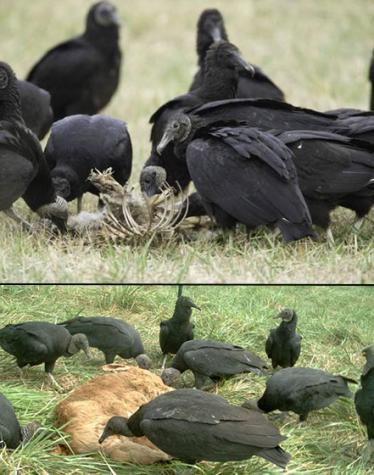Writer
Julie HarkerCOLUMBIA, Mo. – Missouri’s growing population of black vultures has led to increasing attacks on vulnerable livestock. Black vultures often inflict damage to the eyes and tongues of young livestock, kill and feed on domestic fowl and scar animals that survive.
A new MU Extension guide provides information for livestock producers to prevent and control problems with black vultures. “Controlling Nuisance Black Vultures in Missouri,” available at extension.missouri.edu/publications/g9466, was developed by MU Extension state wildlife and fisheries specialist Bob Pierce and Travis Guerrant, Wildlife Services state director for Missouri and Iowa at the USDA Animal and Plant Health Inspection Service.
The guide details nonlethal damage control techniques, including the use of effigies, lasers, pyrotechnics or loud noises to scare vultures, and provides livestock management recommendations such as moving cattle with calves nearer to protected areas, Pierce said.
“Black vultures are legally protected under the Migratory Bird Treaty Act of 1918, so a permit to use lethal control methods is required,” he said. The guide outlines the process for obtaining a permit should it be warranted.
USDA APHIS Wildlife Services is charged with responding to conflicts with migratory species, including black vultures, Guerrant said. He advises Missouri livestock producers who suffer damage from black vultures to first contact the Wildlife Services state office in Columbia at 573-449-3033, ext. 10, to discuss the problem and/or schedule a site visit for a customized damage management plan.
If warranted, livestock owners who have experienced depredation from black vultures may obtain a permit to use limited lethal measures through Missouri Farm Bureau.
Turkey vultures are also common in Missouri, but tend to be less aggressive than black vultures, which are known to gang up and prey on calves, piglets, lambs and newborn goats. Both species are native to Missouri.
Vultures do play a critical role in the environment as scavengers of carrion, reducing the risk of diseases spreading from dead animals, Pierce said.
“While black vultures can be found all the way to Canada, I don’t think that is common,” said Guerrant. “Ten years ago, we rarely saw them in Missouri. Now they are in the state nearly year-round in the far south of the state. I think the warmer winters and food availability are contributing to the northward expansion of their range.”
“As with other wildlife species, they will take advantage of resources that are available to them,” Pierce said. “This can cause issues when it involves conflicts with human dwellings and, in some cases, livestock operations.”
Photo
https://extension.missouri.edu/media/wysiwyg/Extensiondata/NewsAdmin/Photos/2023/20230224-vultures-1.jpg
Black vultures feed on dead animals but can also gang up and prey on calves, piglets, lambs and newborn goats. Photos courtesy USDA National Wildlife Research Center.
